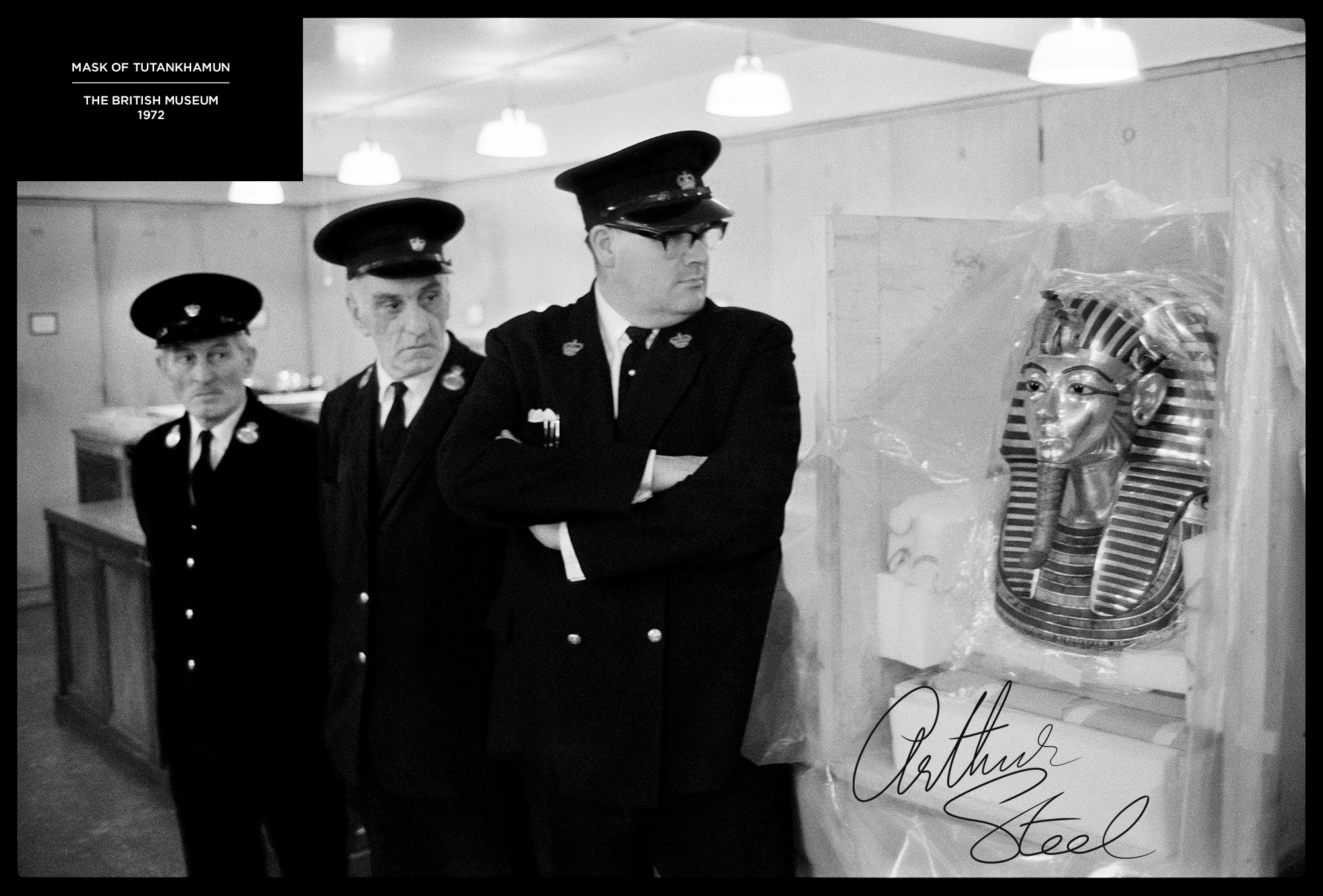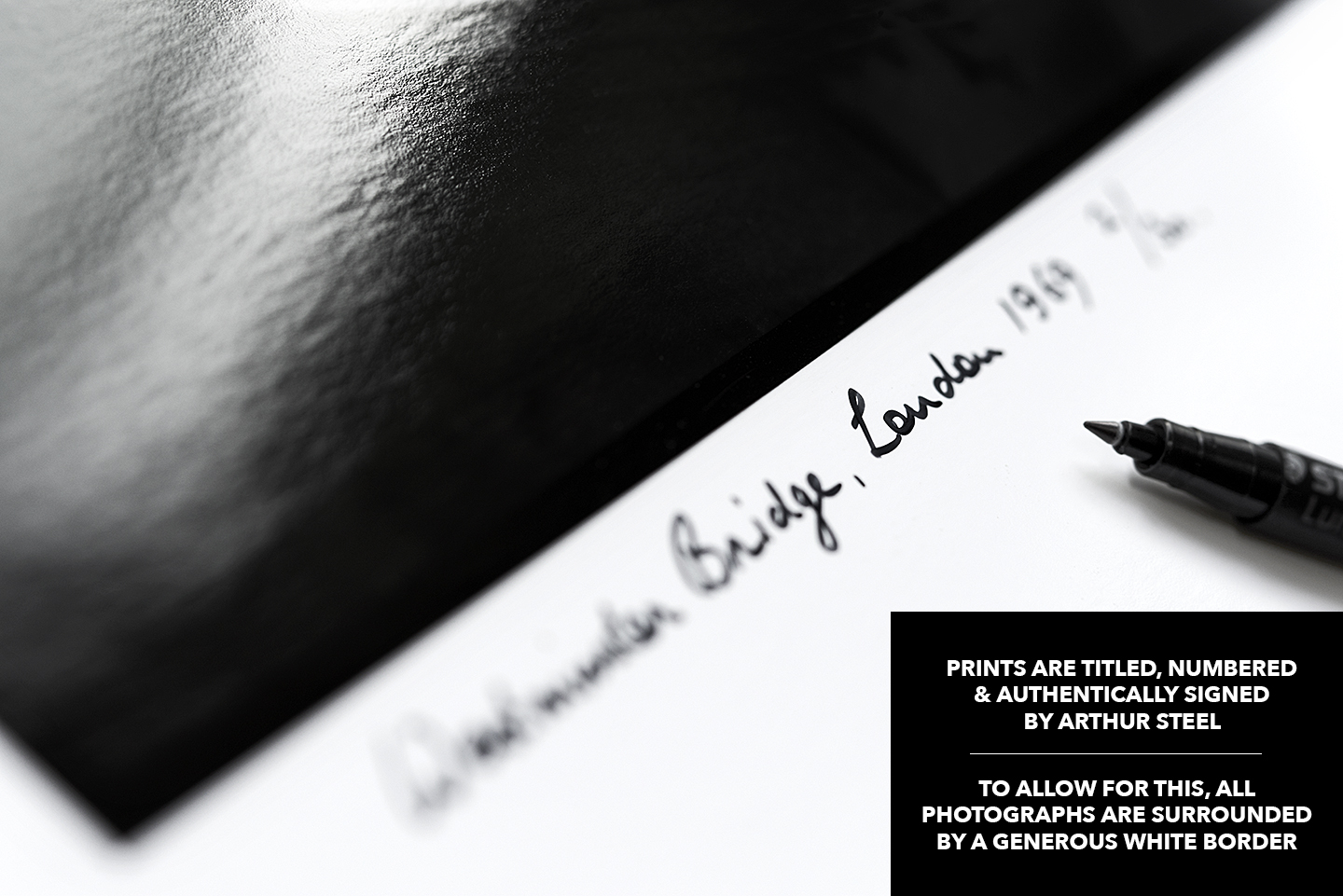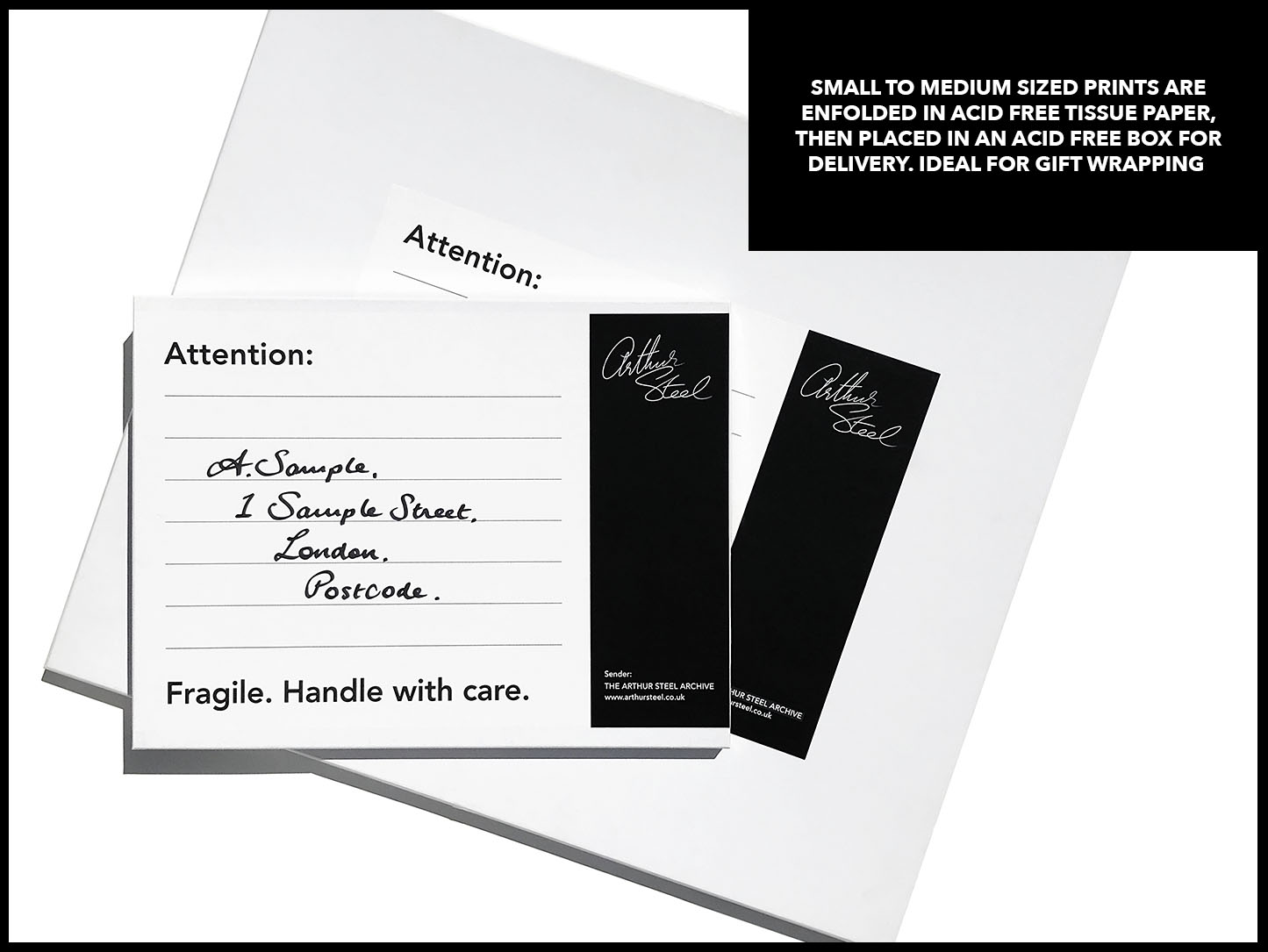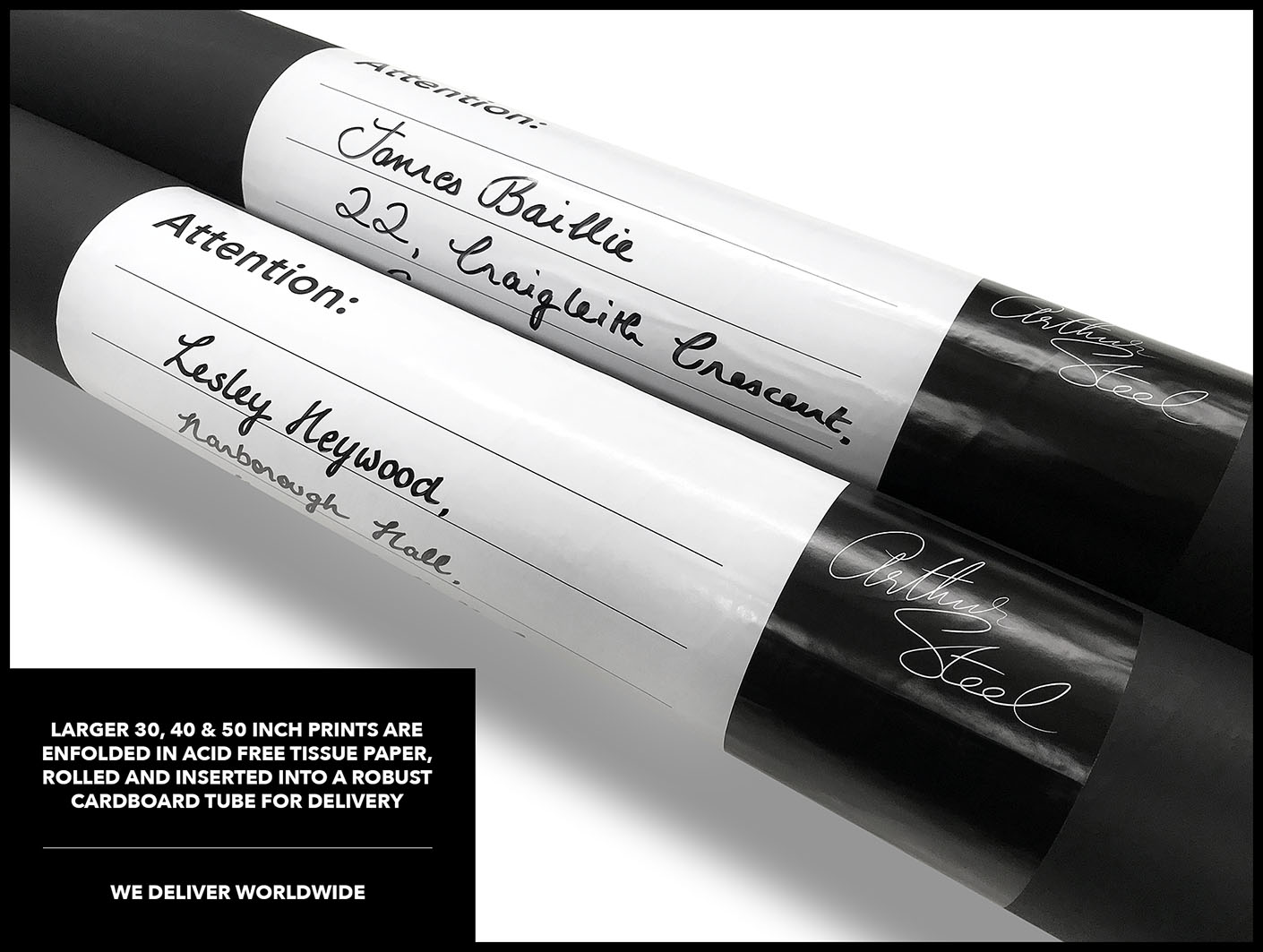Description
An exclusive limited edition photograph by Photojournalist Arthur Steel.
The Gold Mask of Tutankhamun, flanked by three of the Museum’s security guards. The Treasures of Tutankhamun exhibition was shown in London in 1972. The exhibition travelled to many countries including the USA, USSR, Japan, France, Canada and West Germany. During this period, in spite of expert supervision and care, the exhibits unfortunately suffered from their ordeal. The Egyptian Government, in an effort to preserve them from any future stress, made a decision that the Gold Mask of Tutankhamun and many of the major treasures were not to leave their home in Egypt again.
Arthur recalls:
“Approximately 5,000 treasures were found in Tutankhamun’s Tomb but the most famous treasure of all is known as ‘The Gold Mask of King Tut’. For me, the three guards standing next to the magnificent piece make the picture, not only are they standing together in ascending height but their expressions are priceless – just like the mask itself.”
✓ Exceptionally rare limited edition photograph.
✓ Direct from the Artist.
✓ Non licensable images.
✓ Printed by Metro Imaging.
✓ Hand signed by Arthur Steel.
✓ Video of Arthur Steel signing your print(s).
✓ Certificate of Authenticity.
✓ Free worldwide delivery.
✓ Tracked & signed for delivery.
✓ Paypal Pro protection.
✓ Secure SSL payment protection.
✓ 14 day money back guarantee.
✓ Excellent customer care and service.
Black & White Film Grain:
Arthur’s photographs were all captured on 35mm film, a fast medium grain film called ‘Kodak Tri-x Pan’ with an ISO speed of 400. It enabled photojournalists at the time to shoot in relatively low light conditions. Nowadays, we are used to grainless images even at an iso of 800 and above. The grain effect adds to the character and charm of the images and dates the pieces accordingly. Arthur’s images cannot to be compared to todays grainless digital technology.
Signed prints Vs. Unsigned prints:
Most artists sign their prints at the bottom right corner of the piece. By signing a print, the artist approves it, and, claims it as his or her own work. Signatures count for a lot on the print market since they add to the artwork’s authenticity. The value of a signed print is higher than the value of an unsigned print, so if you have a choice, it’s always better to acquire signed prints.
Limited editions Vs. Open editions:
As a rule limited edition prints are valued more highly and therefore are priced higher than the readily available open edition prints. Also, limited edition prints are collectible, which is not the case for open edition prints. Due to their scarcity, limited edition prints are prized, and collectors and art lovers will seek to create a collection of the same.
Camera: Leica 35mm.
Film stock: Kodak Tri-X Pan.
Location: The British Museum, London.
Year: 1972.
Collection: Platinum.
Print Type: Fibre-based Harman Galerie FB Digital.
Printed by: Metro Imaging.
Bespoke: All prints are bespoke and printed to order.
Limited Editions:
All prints are limited editions and no further prints are produced once sold.
60″ prints / edition of 5
50″ prints / edition of 10
40″ prints / edition of 20
30″ prints / edition of 30
20″ prints / edition of 30
12″ prints / edition of 30
Presentation: 12 and 20 inch prints are titled, numbered, signed and carefully enfolded in acid free tissue paper, supplied flat in an acid free 4mm 3-ply box for delivery and storage purposes. The boxes are ideal for gift wrapping. The larger 30, 40, 50 and 60 inch prints are also titled, numbered, signed and carefully enfolded in acid free tissue paper and inserted into a rigid 4mm thick protective cardboard tube for delivery.
Optional Dry Mounting for clients within the UK: Professional Dry Mounting of the larger print sizes can be arranged at no extra cost, the print would then be perfectly flat and ready for framing. However, this makes the overall size bulky and too fragile to send overseas. So, if you reside abroad, it is best that we send a rolled print directly to your chosen framer and you entrust them to carry out the works for you. We recommend that you check that your framer is fully insured as we cannot take responsibility for any damages that may occur during the mounting/framing process.
Delivery: Metro Imaging based in Central London use an experienced shipping service to deliver the boxed and rolled prints. Metro take great care in ensuring the print(s) are very well protected and efficiently delivered anywhere in the UK or overseas. Acid free tissue paper protects prints from scratching/creasing. Metro also offer a vast array of delivery options to suit the recipient’s preference.
Certificate of Authenticity: Each print acquired from The Arthur Steel Archive is accompanied by an individually signed Certificate of Authenticity.
Video of Authenticity: Newly printed bespoke prints are further authenticated by way of a short personalised video. Arthur Steel mentions your name on the recording prior to signing. For example, Arthur will say something like: “I’m signing this print of The Gold Mask of Tutankhamun, edition number 2/20 for Mr. Smith in New York.” For your records, the footage is then sent to you via email.
Watermark: Watermarks will not be present on an original print.
Copyright: © Arthur Steel / The Arthur Steel Archive.
The Mask:
The mask of Tutankhamun is a death mask of the 18th-dynasty ancient Egyptian Pharaoh Tutankhamun (reigned 1332–1323 BC). It was discovered by Howard Carter in 1925 in tomb KV62 and is now housed in the Egyptian Museum in Cairo. The mask is one of the most well known works of art in the world.
According to Egyptologist Nicholas Reeves, the mask is “not only the quintessential image from Tutankhamun’s tomb, it is perhaps the best-known object from ancient Egypt itself.”
The British Museum:
The British Museum, located in the Bloomsbury area of London, in the United Kingdom, is a public institution dedicated to human history, art and culture. Its permanent collection numbers some 8 million works, and is among the largest and most comprehensive in existence having been widely sourced during the era of the British Empire, and documenting the story of human culture from its beginnings to the present. It is the first national public museum in the world.
The British Museum was established in 1753, largely based on the collections of the Irish physician and scientist Sir Hans Sloane. It first opened to the public on 15 January 1759, in Montagu House, on the site of the current building. Its expansion over the following two and a half centuries was largely a result of expanding British colonisation and has resulted in the creation of several branch institutions, the first being the British Museum (Natural History) – now the Natural History Museum – in 1881.
In 1973, the British Library Act 1972 detached the library department from the British Museum, but it continued to host the now separated British Library in the same Reading Room and building as the museum until 1997. The museum is a non-departmental public body sponsored by the Department for Digital, Culture, Media and Sport, and as with all other national museums in the United Kingdom it charges no admission fee, except for loan exhibitions.
It’s ownership of some of its most famous objects originating in other countries is disputed and remains the subject of international controversy, most notably in the case of the Parthenon Marbles.






Recent Comments